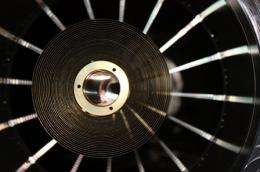German scientists ready for the hunt on dark energy

The German and Russian partners of the new eROSITA X-ray space observatory have now agreed on how to split the data from the first four years of an all sky survey. This decision was announced today at the first dedicated eROSITA conference in Garmisch-Partenkirchen and will enable German astronomers to work with the first full sky X-ray survey since the one carried out by the ROSAT satellite some 20 years ago. The conference is attended by more than 150 astronomers from many different countries and fields of astronomy, showing the broad interest of the international astronomical community in this new observatory that is to be launched in 2013.
The eROSITA X-ray telescope, which is currently under construction by an international consortium led by the Max Planck Institute for Extraterrestrial Physics (MPE) will perform the first imaging all-sky survey in the medium energy X-ray range up to 10 keV with an unprecedented spectral and angular resolution. With the data collected, astronomers will be able to detect and measure not only some 500 000 active stars but also about 100 000 groups and clusters of galaxies and up to three million new, distant supermassive black holes in active galactic nuclei.
The agreement between the German MPE and the Space Research Institute of the Russian Academy of Sciences (IKI), the two main scientific partners of eROSITA, specifies that German astronomers from all the institutions involved will receive data covering 20 000 square degrees of sky - an area hundreds of times bigger than the largest area observed with the XMM-Newton X-ray telescope. While this telescope and its sister, the Chandra X-ray space observatory, are designed for deep observations of tiny areas, eROSITA was specifically developed for large scale observations.
"With eROSITA we will be able to systematically probe the Universe in depth, we can look back in time to where the Universe was half its current age," explains Peter Predehl, who is leading the eROSITA project team. "While the previous X-ray all-sky survey by ROSAT was mainly concerned with the local Universe, eROSITA will enable us to map out the large scale structure in the Universe."
Analysing the large-scale structure evolution as traced by the hot, X-ray emitting gas, will allow the scientists to put new constraints on the mysterious dark energy, which is causing the accelerated expansion of the Universe. While the discovery of this effect was honoured by the Nobel Prize in physics this year, the nature of dark energy remains an open question.
However, as the attendance by astronomers from many fields at the first dedicated eROSITA conference in Germany shows, the project meets with general and broad interest from the international scientific community. Talks and discussions range from prospects for observing galaxy clusters and using them as cosmological probes, to distant active galactic nuclei, black holes and neutron stars in our galaxy, X-ray binary stars and other compact objects. Several collaborations have been proposed with ground-based telescopes observing large areas of the sky in other wavelengths that already do and will provide crucial complementary data to the eROSITA survey.
"At the eROSITA conference, many recent scientific developments are presented that could directly lead to a number of interesting collaborations," says Andrea Merloni, eROSITA project scientist. "The project is now mature enough that we can present it to the international community and listen to their ideas about the scientific potential of eROSITA. Indeed, the interested we generated exceeds our expectations."
The manufacturing of the hardware for eROSITA runs like clockwork: The complete telescope structure has arrived at MPE and for the seven mirror modules (plus one spare), one of the 54 nested mirror shells is integrated per day. Testing shows that all mirrors are of excellent quality. Assembly of the complete hardware including the new X-ray detector system developed at MPE is scheduled for the end of 2012 and then eROSITA will be launched 2013 from Baikonur as the primary instrument on-board the Russian "Spectrum-Roentgen-Gamma" (SRG) satellite and placed in an L2 orbit. The first four years of observations will be dedicated to an all-sky survey followed by three years of pointed observations, for which scientists from all over the world can submit proposals.
More information: www.mpe.mpg.de/erosita/?lang=en
Provided by Max-Planck-Gesellschaft




















